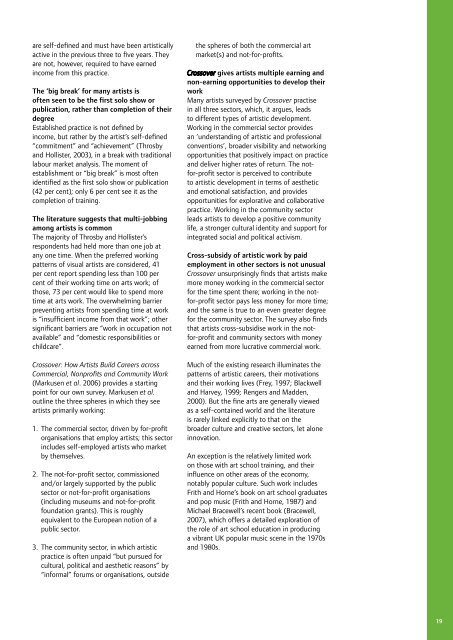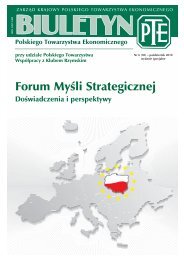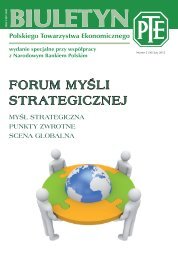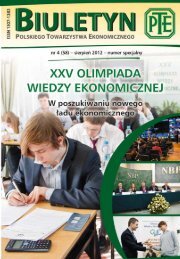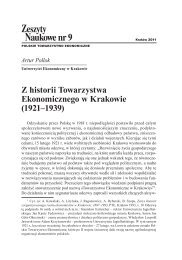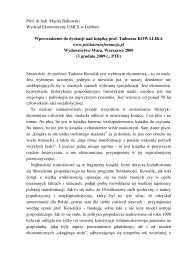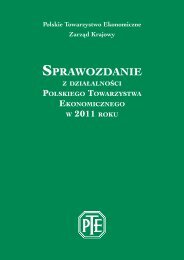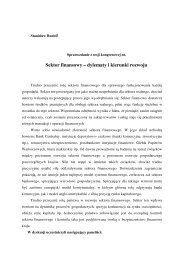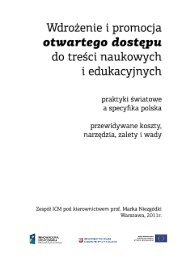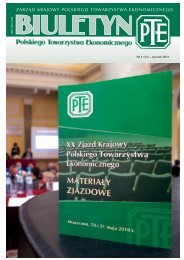The art of innovation - Nesta
The art of innovation - Nesta
The art of innovation - Nesta
Create successful ePaper yourself
Turn your PDF publications into a flip-book with our unique Google optimized e-Paper software.
are self-defined and must have been <strong>art</strong>istically<br />
active in the previous three to five years. <strong>The</strong>y<br />
are not, however, required to have earned<br />
income from this practice.<br />
<strong>The</strong> ‘big break’ for many <strong>art</strong>ists is<br />
<strong>of</strong>ten seen to be the first solo show or<br />
publication, rather than completion <strong>of</strong> their<br />
degree<br />
Established practice is not defined by<br />
income, but rather by the <strong>art</strong>ist’s self-defined<br />
“commitment” and “achievement” (Throsby<br />
and Hollister, 2003), in a break with traditional<br />
labour market analysis. <strong>The</strong> moment <strong>of</strong><br />
establishment or “big break” is most <strong>of</strong>ten<br />
identified as the first solo show or publication<br />
(42 per cent); only 6 per cent see it as the<br />
completion <strong>of</strong> training.<br />
<strong>The</strong> literature suggests that multi-jobbing<br />
among <strong>art</strong>ists is common<br />
<strong>The</strong> majority <strong>of</strong> Throsby and Hollister’s<br />
respondents had held more than one job at<br />
any one time. When the preferred working<br />
patterns <strong>of</strong> visual <strong>art</strong>ists are considered, 41<br />
per cent report spending less than 100 per<br />
cent <strong>of</strong> their working time on <strong>art</strong>s work; <strong>of</strong><br />
those, 73 per cent would like to spend more<br />
time at <strong>art</strong>s work. <strong>The</strong> overwhelming barrier<br />
preventing <strong>art</strong>ists from spending time at work<br />
is “insufficient income from that work”; other<br />
significant barriers are “work in occupation not<br />
available” and “domestic responsibilities or<br />
childcare”.<br />
Crossover: How Artists Build Careers across<br />
Commercial, Nonpr<strong>of</strong>its and Community Work<br />
(Markusen et al. 2006) provides a st<strong>art</strong>ing<br />
point for our own survey. Markusen et al.<br />
outline the three spheres in which they see<br />
<strong>art</strong>ists primarily working:<br />
1. <strong>The</strong> commercial sector, driven by for-pr<strong>of</strong>it<br />
organisations that employ <strong>art</strong>ists; this sector<br />
includes self-employed <strong>art</strong>ists who market<br />
by themselves.<br />
2. <strong>The</strong> not-for-pr<strong>of</strong>it sector, commissioned<br />
and/or largely supported by the public<br />
sector or not-for-pr<strong>of</strong>it organisations<br />
(including museums and not-for-pr<strong>of</strong>it<br />
foundation grants). This is roughly<br />
equivalent to the European notion <strong>of</strong> a<br />
public sector.<br />
3. <strong>The</strong> community sector, in which <strong>art</strong>istic<br />
practice is <strong>of</strong>ten unpaid “but pursued for<br />
cultural, political and aesthetic reasons” by<br />
“informal” forums or organisations, outside<br />
the spheres <strong>of</strong> both the commercial <strong>art</strong><br />
market(s) and not-for-pr<strong>of</strong>its.<br />
Crossover gives <strong>art</strong>ists multiple earning and<br />
non-earning opportunities to develop their<br />
work<br />
Many <strong>art</strong>ists surveyed by Crossover practise<br />
in all three sectors, which, it argues, leads<br />
to different types <strong>of</strong> <strong>art</strong>istic development.<br />
Working in the commercial sector provides<br />
an ‘understanding <strong>of</strong> <strong>art</strong>istic and pr<strong>of</strong>essional<br />
conventions’, broader visibility and networking<br />
opportunities that positively impact on practice<br />
and deliver higher rates <strong>of</strong> return. <strong>The</strong> notfor-pr<strong>of</strong>it<br />
sector is perceived to contribute<br />
to <strong>art</strong>istic development in terms <strong>of</strong> aesthetic<br />
and emotional satisfaction, and provides<br />
opportunities for explorative and collaborative<br />
practice. Working in the community sector<br />
leads <strong>art</strong>ists to develop a positive community<br />
life, a stronger cultural identity and support for<br />
integrated social and political activism.<br />
Cross-subsidy <strong>of</strong> <strong>art</strong>istic work by paid<br />
employment in other sectors is not unusual<br />
Crossover unsurprisingly finds that <strong>art</strong>ists make<br />
more money working in the commercial sector<br />
for the time spent there; working in the notfor-pr<strong>of</strong>it<br />
sector pays less money for more time;<br />
and the same is true to an even greater degree<br />
for the community sector. <strong>The</strong> survey also finds<br />
that <strong>art</strong>ists cross-subsidise work in the notfor-pr<strong>of</strong>it<br />
and community sectors with money<br />
earned from more lucrative commercial work.<br />
Much <strong>of</strong> the existing research illuminates the<br />
patterns <strong>of</strong> <strong>art</strong>istic careers, their motivations<br />
and their working lives (Frey, 1997; Blackwell<br />
and Harvey, 1999; Rengers and Madden,<br />
2000). But the fine <strong>art</strong>s are generally viewed<br />
as a self-contained world and the literature<br />
is rarely linked explicitly to that on the<br />
broader culture and creative sectors, let alone<br />
<strong>innovation</strong>.<br />
An exception is the relatively limited work<br />
on those with <strong>art</strong> school training, and their<br />
influence on other areas <strong>of</strong> the economy,<br />
notably popular culture. Such work includes<br />
Frith and Horne’s book on <strong>art</strong> school graduates<br />
and pop music (Frith and Horne, 1987) and<br />
Michael Bracewell’s recent book (Bracewell,<br />
2007), which <strong>of</strong>fers a detailed exploration <strong>of</strong><br />
the role <strong>of</strong> <strong>art</strong> school education in producing<br />
a vibrant UK popular music scene in the 1970s<br />
and 1980s.<br />
19


